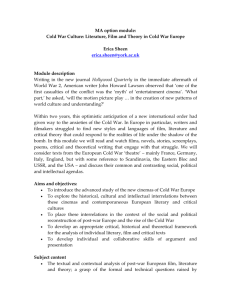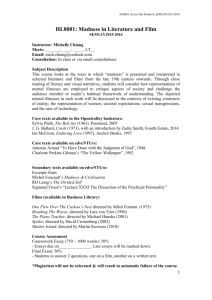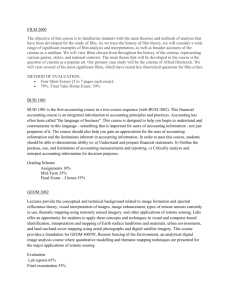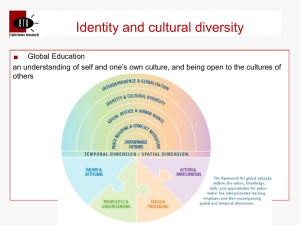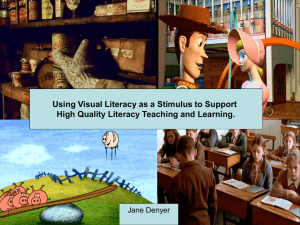Teaching Film
advertisement
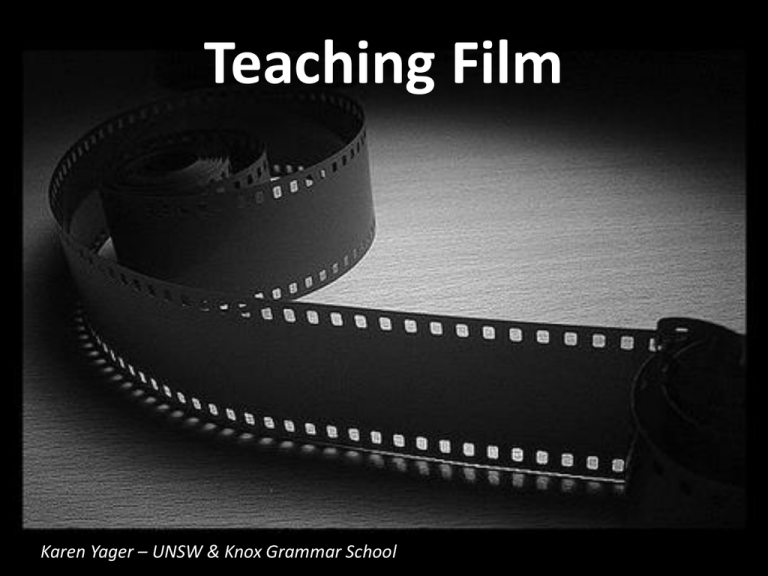
Teaching Film Karen Yager – UNSW & Knox Grammar School Stage 4 Outcomes Outcome 1: A student responds to and composes texts for understanding, interpretation, critical analysis and pleasure. Outcome 2: A student uses a range of processes for responding to and composing texts. A student uses and describes language forms and features, and structures of texts appropriate to different purposes, audiences and contexts.(4.8: in visual texts: medium, organisation, colour, layout, perspective, focus, camera angles and editing) Outcome 6: A student draws on experience, information and ideas to imaginatively and interpretively respond to and compose texts. Outcome 8: A student makes connections between and among texts. Outcome 9: A student demonstrates understanding that texts express views of their broadening world and their relationships within it. (9.10: narrative techniques in film-making and in the media, including their use in news and current affairs reporting and 9.11: film and media techniques used in representing people, places and events.) Culture of learning What do I want my students to learn? Why does it matter? What do they already know? How will they demonstrate learning? How will they get there? How well do I expect them to do it? Film as Text Close or critical study Visual link to a concept or theme Creating Auteur Book or film trailer Stimulus for writing Documentaries Transformation Analysis Explicitly teach film techniques Act of representation Characterisation Connections through themes or ideas Contextualisation Strategies Picture books and posters to introduce visual techniques Short films and trailers Mise-en-scene Sound off Group or individual tasks focussed on an aspect of the film Jigsaw or cafes Assessment Creativity: Creating a storyboard or film script http://celtx.com/. Film: Moviemaker, iMovie or Final Cut Pro Comics: - http://goanimate.com/ - Comic life: http://comiclife.en.softonic.com/ - Toondoo: http://www.toondoo.com/ Home.toon - http://superherosquad.mar vel.com/create_your_own_ comic Suggested Films Stage 4 Stage 5 Anime: Howl’s Moving Castle, Spirited Away, My Neighbour Totoro, Birthday Bird Fantasy: Harry Potter films, Never Ending Story, The Princess Bride, Tangled, Ever After, Willow, Labyrinth, Alice in Wonderland Babe Mulan Bend it Like Beckham E.T. To Kill a Mocking Bird The Secret of Roan Inish The Secret Garden Bridge to Terabithia Whale Rider Nim’s Island Iron Giant Diary of a Wimpy Kid Coralline Lemony Snickett: A Series of Unfortunate Events The Black Balloon The Lord of the Rings The Matrix The Fifth Element Edward Scissorhands Brassed Off Stand By Me Holes A Knight’s Tale Nightmare Before Christmas The Boy in Striped Pyjamas Big Fish The Hitchhiker’s Guide to the Galaxy October Sky Resources Vancouver Film School Australian Screen or Film Australia: http://aso.gov.au/titles/alpha/A/ http://www.filmeducation.org/ http://www.mediaed.org.uk/component/option,com_f rontpage/Itemid,1/ http://mediateacher.squarespace.com/film-teachingguides/ http://www.metromagazine.com.au/index.html http://dave.net.au/online/filmandvid/glossary.pdf http://teachfilmstudy.com/litToFilm.htm Subjective Frame Personal Response: How do I respond to this image? 1. What do you feel? 2. What does it remind you of? 3. What is the composer conveying in this image about the subject and the times? Structural Frame Techniques: How does the film make meaning? 1. Visual techniques 2. Framing 3. Composition 4. Salience 5. Gaze 6. Vectors 7. Demand and Offer 8. Medium of production Cultural Frame Context: How would this image have been received, and how does it reflect its times? 1. Historical: When and where? 2. Cultural: 3. Political 4. Social 5. Responder’s context 6. Impact on Meaning? Critical Frame Representation: How could this image be read? 1.Gaps and silences 2.Manipulatio n of image 3.Positioning of responder
